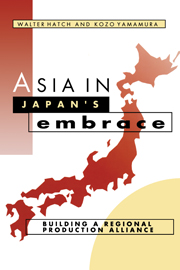Book contents
- Frontmatter
- Contents
- List of Tables
- List of Figures
- Preface
- Part One Co-Prosperity Again
- Part Two The Embracer and the Embraced
- 3 Cooperation between Unequals
- 4 The Political Economy of Japan
- 5 The Political Economy of Asia
- 6 Holding Technology
- Part Three A Japanese Alliance in Asia
- Part Four A Powerful Embrace
- Notes
- Select Bibliography
- Index
3 - Cooperation between Unequals
Published online by Cambridge University Press: 05 February 2012
- Frontmatter
- Contents
- List of Tables
- List of Figures
- Preface
- Part One Co-Prosperity Again
- Part Two The Embracer and the Embraced
- 3 Cooperation between Unequals
- 4 The Political Economy of Japan
- 5 The Political Economy of Asia
- 6 Holding Technology
- Part Three A Japanese Alliance in Asia
- Part Four A Powerful Embrace
- Notes
- Select Bibliography
- Index
Summary
In 1993, a Nobel laureate in economics complained that the world envisioned in neoclassical theory exists “in the minds of economists but not on earth.” This may be a little harsh, but only a little. In this chapter, we argue that neoclassical theory cannot cope with the reality of Japan's embrace of Asia because it ignores or assumes away institutions (such as government, business alliances, and labor agreements) and fails to seriously consider the critical role of technological change in economic development.
We should concede at the outset that neoclassical theory has allowed many people, including us, to organize economic concepts more clearly and examine data more deliberately. But this analytical tool has proved to be blunt, even flawed – an unfortunate fact that too many neoclassical economists at colleges and think tanks all over the world refuse to recognize. Giddy with self-confidence, they continue to pound away, deluding themselves into thinking they are asking the right questions and getting the right answers. In doing so, they remind us of that old saying: if the only tool you have is a hammer, everything looks like a nail.
This chapter has three objectives. One is to summarize the shortcomings of neoclassical economic analysis, particularly the theory of the firm and the theory of international trade – the two theories relied on most often to analyze the motives, patterns, and significance of Japanese economic expansion into Asia.
- Type
- Chapter
- Information
- Asia in Japan's EmbraceBuilding a Regional Production Alliance, pp. 43 - 61Publisher: Cambridge University PressPrint publication year: 1996

